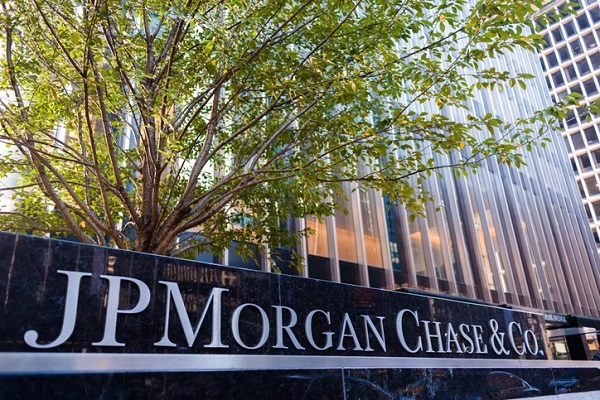ii view: JP Morgan profits beat but CEO offers bleak outlook
This US banking mammoth fell 15% last year but is up almost 10% in 2023. Buy, sell, or hold?
13th October 2023 15:46
by Keith Bowman from interactive investor

Third-quarter results to 30 September
- Revenue up 21% to $40.69 billion
- Net income up 35% to $13.15 billion
- Earnings per share up 35% to $4.33
Chief executive Jamie Dimon said:
“Currently, US consumers and businesses generally remain healthy, although consumers are spending down their excess cash buffers. However, persistently tight labour markets as well as extremely high government debt levels with the largest peacetime fiscal deficits ever are increasing the risks that inflation remains elevated and that interest rates rise further from here.
“Additionally, we still do not know the longer-term consequences of quantitative tightening, which reduces liquidity in the system at a time when market-making capabilities are increasingly limited by regulations. Furthermore, the war in Ukraine compounded by last week’s attacks on Israel may have far-reaching impacts on energy and food markets, global trade, and geopolitical relationships.
“This may be the most dangerous time the world has seen in decades. While we hope for the best, we prepare the Firm for a broad range of outcomes so we can consistently deliver for clients no matter the environment.”
- Invest with ii: Buy US Stocks from UK | Most-traded US Stocks | Cashback Offers
ii round-up:
US bank JPMorgan Chase & Co (NYSE:JPM) today detailed revenues and earnings which beat Wall Street estimates as higher interest rates pushed net interest income up and credit provisions proved lower than feared.
Helped along by its takeover of First Republic Bank earlier this year, third quarter revenue rose by just over a fifth to $40.69 billion, pushing earnings up by just over a third to $4.33 per share. That beat analyst forecasts for $39.6 billion and $3.12 per share.
Shares in the Dow Jones company rose more than 3% in US trading having come into this latest news up by a tenth year-to-date. That’s in contrast to a 6% fall for European rival Deutsche Bank AG (XETRA:DBK), although below a one-quarter gain for Asia-focused HSBC Holdings (LSE:HSBA). The Dow itself is up around 1.5%.
Higher net interest income fed into a 29% gain in revenues for JP Morgan’s traditional banking business to $18.4 billion, or 19% excluding First Republic. Profit for the traditional banking division climbed 36% to $5.9 billion, or 22% before First Republic. Bad debt provisions totalled $1.4 billion, down from $1.86 billion in the second quarter.
Revenues for JPM's Corporate and Investment Banking division retreated 2% to $11.7 billion, hindered by lower advisory fees and by a tough year-over-year comparison for its equity related business. Overall divisional profit fell 12% to $3.1 billion.
The New York headquartered bank’s capital cushion, or CET1 ratio rose to 14.3% from the previous quarter’s 13.8%. Assets under management for its wealth division increased 22% to $3.2 trillion, aided by net fund inflows.
The bank previously declared a quarterly dividend of $1.05 per share, up from the prior quarter’s $1 per share. Fourth-quarter results are scheduled for 12 January.
ii view:
Tracing its history back to 1799, JP Morgan today employs around 300,000 people. A stock market value of over $420 billion is comfortably ahead of rivals Bank of America Corp (NYSE:BAC) at around $210 billion and Wells Fargo & Co (NYSE:WFC) at $145 billion. Its home North American market generates its biggest slug of business at around three-quarter of overall revenue, with its combined Europe and Africa region next at over a tenth.
For investors, cautious outlook comments from the highly experienced head Jamie Dimon deserve consideration. A hike too far in interest rates could push the US economy into recession, potentially creating additional bad-debt provisions. Activity at its investment bank also remains relatively subdued, while an estimated price-to-net value of around 1.5 times is comfortably above most rivals, suggesting the shares are not cheap.
- US bank sector earnings season: high expectations for these big players
- What Arm and Birkenstock tell us about state of global IPO market
- Lloyds Bank shares: Q3 2023 results preview and new price target
More favourably, heightened interest rates have increased overall revenues, the benefits of a diversified business model covering both traditional and investment banking are historically evident, and bad debt provisions taken in the past have regularly proved more than sufficient to cover actual future defaults. A forecast dividend yield of close to 3% is also respectable.
For now, and despite ongoing risks, this well managed US banking giant arguably continues to justify its place in diversified investor portfolios.
Positives:
- Business diversity
- Relatively attractive dividend (not guaranteed)
Negatives:
- Economic outlook uncertainty
- Elevated costs
The average rating of stock market analysts:
Buy
These articles are provided for information purposes only. Occasionally, an opinion about whether to buy or sell a specific investment may be provided by third parties. The content is not intended to be a personal recommendation to buy or sell any financial instrument or product, or to adopt any investment strategy as it is not provided based on an assessment of your investing knowledge and experience, your financial situation or your investment objectives. The value of your investments, and the income derived from them, may go down as well as up. You may not get back all the money that you invest. The investments referred to in this article may not be suitable for all investors, and if in doubt, an investor should seek advice from a qualified investment adviser.
Full performance can be found on the company or index summary page on the interactive investor website. Simply click on the company's or index name highlighted in the article.